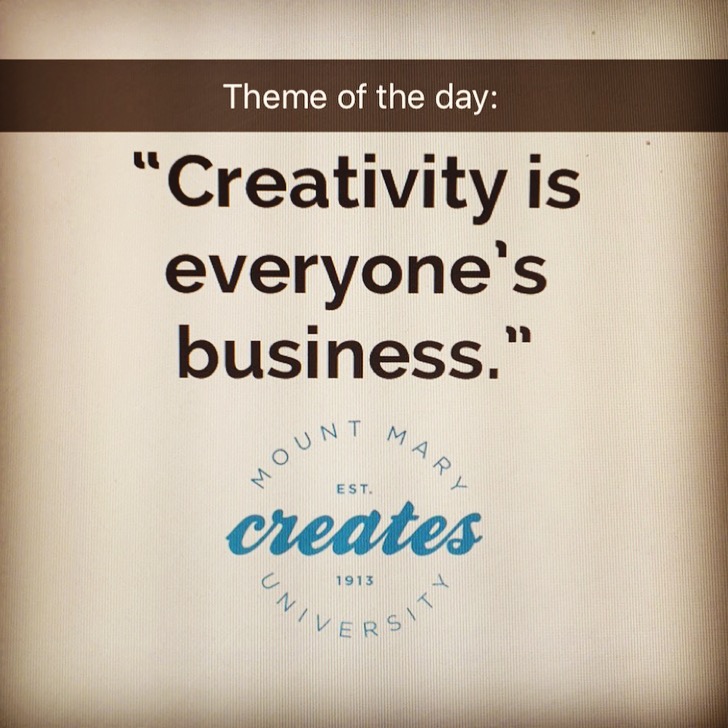The innovation equation: Mount Mary's creative initiatives garner local respect
Mount Mary University is leading the creative transformation in the community.
 How does a community encourage meaning, purpose - and creativity? This is a significant question for educators and business leaders alike, says Maggie Jacobus, president and CEO of Creative Alliance Milwaukee.
How does a community encourage meaning, purpose - and creativity? This is a significant question for educators and business leaders alike, says Maggie Jacobus, president and CEO of Creative Alliance Milwaukee.
Even today, as STEM skills gain increasing emphasis within mainstream education, those math and science, critical thinking skills shouldn't trump creativity, Jacobus said. She applauds Mount Mary's Creative Campus initiative, which challenges all subjects to be taught in ways that inspire agility, experimentation, imagination, open-mindedness and enable people to navigate complexity.
Creating an innovative mindset requires the ability to think both analytically and creatively in equal measure. She calls this ratio the 'innovation equation.'
The idea of infusing creativity into the curriculum has long-reaching implications, Jacobus said, particularly as Milwaukee continues to define innovation as a key driver of economic growth.
"Mount Mary University is leading the transformation in the community," she said during a recent all-University Workshop. "It is a breakthrough to bundle skills in this way."
An example of Mount Mary's creative approach is evident in the STEAM program, for example, which interjects art and design into the conventional STEM lineup of technology skills: Science, technology, engineering and math.
"Creativity is a process, a talent, an output, part of a continuum, and a skill set." @mkecreative#AllUniversity
- Mount Mary (@MountMary) January 11, 2016
Jacobus said the workforce of the 21st Century will need to engage in "whole-brain thinking" to navigate the complexity of the world and the workplace. Along with being a subject matter expert they must know how to take risks, brainstorm, and find new ways to lead and innovate.
"The day of being considered a right-brain or left-brain thinker are over," she said. "Teaching creativity offers your graduates a leg-up in the world of work," she said.
Because of the active nature of creativity, faculty member Laura Kane said that she never stops thinking about projects or ideas, she simply puts them on the back burner.
"Creativity has you thinking constantly, all the time," said Kane, who teaches in the fashion department. Her husband is also a teacher, and her personal sounding board.
"Talking through my ideas helps me sort out everything that's in my head," she said. "I look forward to having more opportunities within departments to discuss our ideas." 
Making sure companies and institutions acknowledge the importance of creativity within the local economy is Jacobus' mission through Creative Alliance Milwaukee. Part of the group's work has been in quantifying the economic impact of those who work within creative fields.
They determined that the creative industry within the metro Milwaukee area comprises 4.2 percent of the region's workplace, generating $2 billion in wages and encompassing industries from design and media to visual and performing arts.
"Creativity is a skill that can be taught, learned and enhanced," Jacobus said. "I commend Mount Mary for taking a leadership role in this area."
How creative are you?
Creativity isn't based upon one's ability to paint a picture or sing a song. It is a skill that can be cultivated, said Maggie Jacobus of Creative Alliance Milwaukee. She offers these tips:
- Don't judge: At the beginning of a project, don't squash your ideas or the ideas of others. Give yourself the opportunity to brainstorm.
- Get unstuck: "Being stuck on what is makes you less receptive to what might be," Jacobus said.
- Take risks: Try it, you might like it.
- Don't stop too soon: Your first idea, even your second one, might not be the best ideas. If you stop the creative free-flow too soon, you risk putting all your effort into executing mediocre ideas.
- Bad ideas aren't so bad: Think of bad ideas as fertilizer, Jacobus said. "The best creative thinkers produce more fertilizer than others."